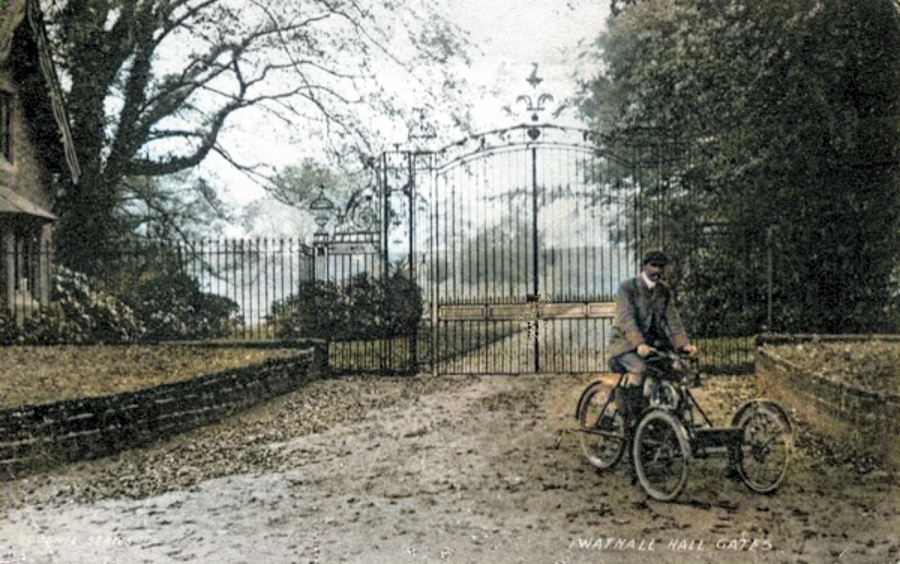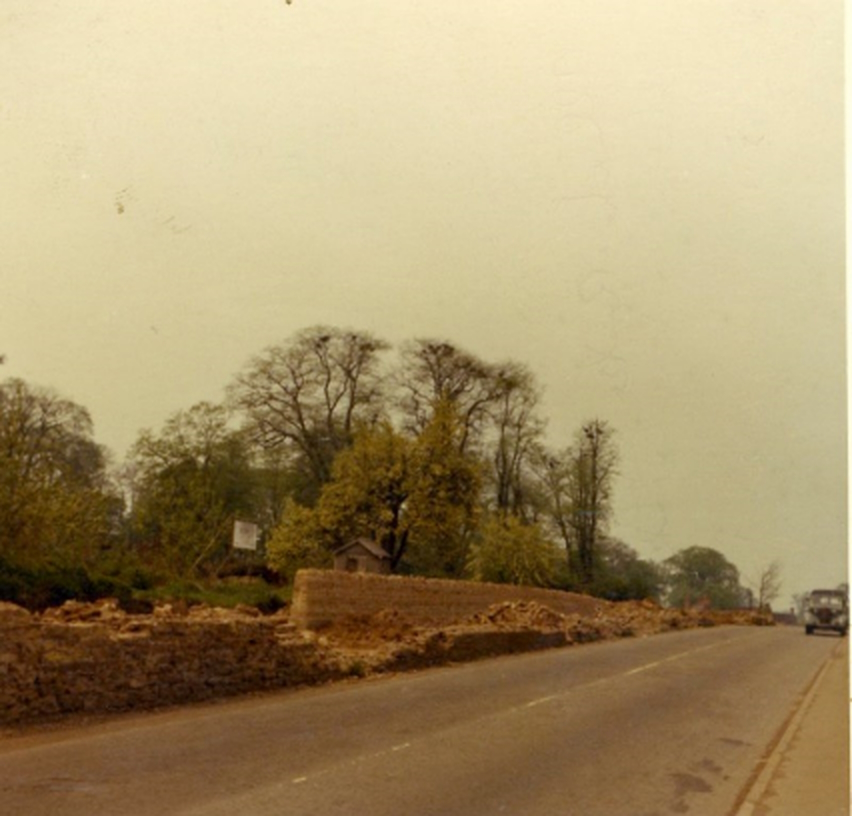 |
| c.1920 - The pre-tarmac main road outside Watnall Hall's gates on the left. Only the gate pillar with its ball on top and part of the wall remains. Source: Nottinghamshire Archives. |
"WATNALL, a charming village which we remember for its neat cottages, stately trees, and the fine entrance to the drive of the great house, all in happy company on a lovely bit of road with holly-crowned walls. Well worthy of admiration are the great iron gates of Watnall Hall, shaded by mighty trees. Probably wrought by Huntingdon Shaw, the Nottingham blacksmith of renown, they bear a gilded eagle's head, the crest of the ancient family of Rollestons, who have lived here since the time of Queen Elizabeth. Formerly these same gates occupied a different position. They served to guard a flight of ancient and worn stone steps, almost immediately in front of the house. To that time belongs part of their house, standing on high ground in a park of 60 acres with fine old timber. It looks across to the hills of Annesley, where lived Mary Chaworth, Byron's first love; and from there she came to dance at Watnall's famous balls. We remember the village, too, as the beginning of a fine little ride down the hollow and up the hill to where the bells in Greasley's lofty tower call the folk to church. It is a lovely mile, with beauty all the way."
 |
| c.1935 - Watnall Hall from the garden looking up the ancient stone steps Note the small dog sitting at the top, the Rolleston's pet terrier Prinkey. Source: Courtesy of the Rolleston Estate. |
 |
| c.1935 - Watnall Hall in its prime with the old squire, Colonel Rolleston standing guard. Source: Courtesy of the Rolleston Estate. |
 |
| The old squire, Sir Lancelot Rolleston and his wife Lady Maud Rolleston in the Rose Garden at Watnall Hall c.1935. Source: Courtesy of the Rolleston Estate. |
 |
| c.1920 - A little closer to the Watnall hall gates. The thatched cottage was demolished for road widening. Source: Nottinghamshire Archives. |
 |
| The same thatched cottage from the previous picture with scaffolding in order to make repairs or replace the thatched roof; possibly taken c.1920s-c.1930s. Source: Nottinghamshire Archives. |
 |
| A coloured postcard of the Watnall Hall's entrance gates c.1903. The "bike" is a Humber Forecar motorbike made in Beeston, Nottingham. Source: Peveril postcards collection. |
 |
| Watnall Hall's gates and gatehouse. It is still there but much altered and extended. |
 |
| c.1900 - A little further round the corner, this coloured postcard shows the Queen's Head pub, main B600 road and Watnall Hall's retaining wall opposite. The road is considerably wider today. The landlord at the time was local auctioneer Mr. Graham Holmes. Read his story here. The landlord after c.1906 was the legendary Joe Haywood. Read his story here. Along the other side of the wall, on the Hall side, was a large golden drop plum trained to grow along the wall. The village lads knew of these fruits too, and often would climb up and sample the plums. Mr. Peart, Watnall Hall's gardener said that he suspected the village policeman would help himself on occasion too, but he could never prove it! The postcard cation says... "The Queen's Head stands alongside the old coaching road to Nottingham. Its first recorded licence dates back to 1801 when it was operating as a coaching inn." The B600 road is the old Nottingham to Newhaven turnpike created in 1759. Chain Cottage at Watnall Corner is so called as there was an actual chain across the road and a toll house where stage coaches and road users paid to use the road. Source: Peveril postcards collection. |
 |
| 30 Oct 1933 - Watnall Corner - schoolmaster and local history teacher Mr. John Hobbs's old cottage on left, now replaced with a brick cottage. Road is now tarmaced. A right turn would take you down the old Church Hill. Source: Courtesy of Stanton Ironworks collection (Stanton's made the signpost!). |
 |
| Mr. John Hobbs's old cottage at Watnall Corner. The stone wall and tree in the foreground are gone. Courtesy of Carolynn Hobbs. |
This same stretch of road, driven by horse and trap, gets a few mentions in DH Lawrence's work...
 |
| Watnall Hall's rose garden and orangery c.1935 Source: Courtesy of the Rolleston Estate. |
 |
| Sir Lancelot and Lady Maud posing by a garden gate for their Golden Wedding in 1932. Source: Debbie Hazeldine. |
 |
| The track to from Alma Hill to Reckoning House Farm before the trees were planted. Source: Flickr (c) Lenton Sands. |
Notes





Comments
Post a Comment